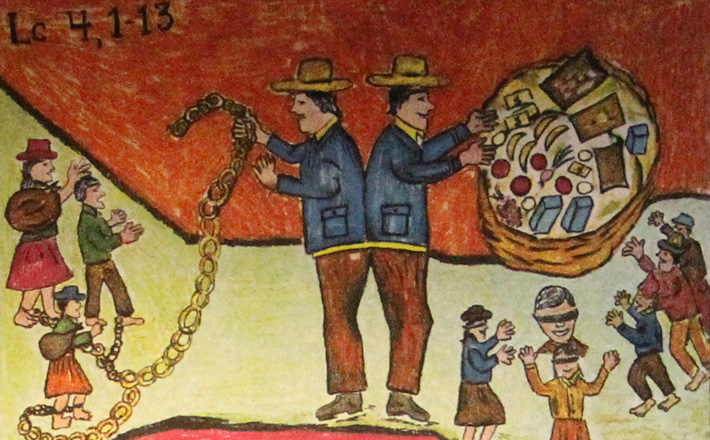Commentary on Luke 4:1-13
During Lent the church often focuses on repentance, resisting temptation, and the passion of Jesus.
Today’s text reminds us that our capacity to repent and to resist temptation comes from our relationship with God and the grace of his deliverance rather than from our own strength and initiative.
We live in a world of competing stories. In such a world, we must know the Christian story in order to resist the false stories that seek to take us captive. The reading in Luke 4:1-13 is the familiar story of Jesus’ temptation by the devil in the wilderness. This story is so well known that we sometimes conflate the different accounts in Matthew, Mark, and Luke into one story about Jesus’ temptation. But each account is unique from the others. Another study might compare the three different accounts and how those accounts fit the theological goals of the evangelists, but we will focus on Luke’s account of Jesus’ temptation. As we read Luke’s version carefully, we can see two competing stories: the story that Jesus taps into in order to resist the devil and successfully navigate the temptations laid before him and the narrative the devil presents.
Setting:
This story takes place in two significant locations: the wilderness and Jerusalem. Historically, the wilderness was the place where God met the Jewish people at Sinai after rescuing them from Egypt. In the wilderness God shaped them into God’s covenant people cared for and led by God with cloud and fire. In Luke’s Gospel, Jesus is also led, this time by the Holy Spirit, in the wilderness, and he faces temptation by his adversary, the devil. The location of Jesus’ temptation in the wilderness reminds us of the narrative of God’s rescue of Israel. Geographically, the wilderness was an arid region in southern Israel between the fertile land near the Mediterranean Sea and the interior desert regions. It was not devoid of life such as one might imagine if thinking about the sands of the Sahara desert but was rather a place that only produced food for flocks when there were abundant rains.
Jerusalem, the city of David, is the center of Jewish power, identity, and worship. At the time of Jesus, the second temple had been renovated and expanded by Herod the Great and was the center of worship for the Jewish people. This place of power and worship is the setting for the final temptation.
Characters:
We have already been introduced to Jesus in Luke’s gospel. He is the Son of God (Luke 3:38) who will bring salvation to both Jews and Gentiles (Luke 2:29-32), and who has been baptized in and is filled with the Holy Spirit (Luke 3:22; 4:1). Now, Jesus is led into the wilderness. This is our first introduction to the devil in Luke’s gospel. From the text, we see that he is bold, cunning, clever, and powerful. It is the devil who tempts, and the devil ends the temptation and departs from Jesus.
Plot:
Most of the story takes place in the dialogue between Jesus and the devil. Jesus was hungry after fasting for 40 days. During those days of fasting he was being tempted by the devil (the verb in v. 2 “being tempted” is a present participle that indicates ongoing action). The account here is of the final three temptations that Jesus encounters at the end of those 40 days. In each temptation, the devil speaks first and Jesus replies. The story ends when the devil finishes the temptation and leaves Jesus, for the time being.
Storylines:
Underlying the dialogue between the devil and Jesus are two competing storylines. The devil offers a storyline of self-indulgence (make yourself bread from stones), self-aggrandizement (all the nations of the world will belong to you if you worship me), and self-serving religious identity (if you are the son of God cast yourself from the top of the temple). Meanwhile, Jesus responds with quotations drawn from the Old Testament that show awareness of the true source of life and identity (he knows that life is more than food), his reliance on God (the one worthy of true worship and service), and his understanding of God’s character (not one to be tested). Jesus’ responses are rooted in an underlying narrative that he is dependent on God rather than self for life, glory, and identity.
The Temptations:
The temptations that the devil presents are aimed at the heart of Jesus’ identity. Twice (vv. 3,9) the devil begins his temptation by calling into question Jesus’ identity as the Son of God with the words “if you are the Son of God” followed by a challenge to prove this identity with some miraculous display (stone into bread (v. 3); a dramatic angelic rescue from death (vv. 9-11)). In the first 3 chapters of Luke, Jesus’ identity was confirmed by Mary, Elizabeth, Simeon, Anna, John the Baptist, and the genealogy in Luke 3. Jesus did not have to do anything to prove his identity or to earn commendation as the Son of God. He is declared to be the one who will bring salvation to his people. This is who he is, Son of God, Savior, but the devil over and over tempts him to display his identity in self-serving ways that would undermine his identity as the Son who relies on the good gifts of the Father. It is worth remembering that in the families of the ancient world an adult son was often understood as the father’s representative and the father and the son would work together to accomplish the family goals. The son’s identity, honor, and status is rooted in his family’s honor and status. Jesus does not need to gain these things by giving in to the devil’s temptations.
Use of Scripture:
Both Jesus and the devil quote Scripture. In response to temptation, Jesus quotes from Deuteronomy, but it is not enough to know Scripture. The devil, who quotes from Psalm 91, also knows Scripture. Scripture must be read rightly in light of God’s nature and the life envisioned for God’s people. Such a life is rooted in God’s narrative of deliverance and a response of faithful obedience to God rather than in self-reliance, which is the devil’s story.


February 14, 2016